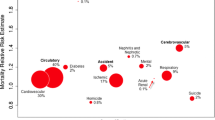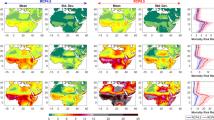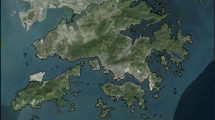Abstract
Illness and mortality related to heat and worsening air quality are core public health concerns associated with climate change projections. We examined the historical relationship between age- and cause-specific mortality rates from 1980 through 2006 and heat events at the 99th percentile of humidex values in the historic period from January 1, 1970 to December 31, 2006 in the greater Seattle area (King, Pierce and Snohomish counties), Spokane County, the Tri-Cities (Benton and Franklin counties) and Yakima County; the relative risks of mortality during heat events were applied to population and climate projections for Washington State to calculate number of deaths above the baseline (1980–2006) expected during projected heat events in 2025, 2045 and 2085. Three different warming scenarios were used in the analysis. Relative risks for the greater Seattle area showed a significant dose-response relationship between heat event duration and daily mortality rates for non-traumatic deaths for persons ages 45 and above, typically peaking at four days of exposure to humidex values above the 99th percentile. The largest number of projected excess deaths in all years and scenarios for the Seattle region was found for age 65 and above. Under the middle warming scenario, this age group is expected to have 96, 148 and 266 excess deaths from all non-traumatic causes in 2025, 2045 and 2085, respectively. We also examined projected excess deaths due to ground-level ozone concentrations at mid century (2045–2054) in King and Spokane counties. Current (1997–2006) ozone measurements and mid-twenty-first century ozone projections were coupled with dose-response data from the scientific literature to produce estimates overall and cardiopulmonary mortality. Daily maximum 8-h ozone concentrations are forecasted to be 16–28% higher in the mid twenty-first century compared to the recent decade of 1997–2006. By mid-century in King County the non-traumatic mortality rate related to ozone was projected to increase from baseline (0.026 per 100,000; 95% confidence interval 0.013–0.038) to 0.033 (95% CI 0.017–0.049). For the same health outcome in Spokane County, the baseline period rate of 0.058 (95% CI 0.030–0.085) was estimated increase to 0.068 (95% CI 0.035–0.100) by mid-century. The cardiopulmonary death rate per 100,000 due to ozone was estimated to increase from 0.011 (95% CI 0.005–0.017) to 0.015 (0.007–0.022) in King County, and from 0.027 (95% CI 0.013–0.042) to 0.032 (95% CI 0.015–0.049) in Spokane County. Public health interventions aimed at protecting Washington’s population from excessive heat and increased ozone concentrations will become increasingly important for preventing deaths, especially among older adults. Furthermore, heat and air quality related illnesses that do not result in death, but are serious nevertheless, may be reduced by the same measures.
Similar content being viewed by others
References
American Academy of Pediatrics, Committee on Sports Medicine and Fitness (2000) Climatic heat stress and the exercising child and adolescent. Pediatrics 106:158–159
Avise J, Chen J, Lamb B, Wiedinmyer C, Guenther A, Salathé E, Mass C (2008) Attribution of projected changes in US ozone and PM2.5 concentrations to global changes. Atmos Chem Phys Discuss 8:15131–15163
Basu R, Dominici F, Samet JM (2005) Temperature and mortality among the elderly in the United States: a comparison of epidemiologic methods. Epidemiology 16:58–66
Bell ML, McDermott A, Zeger SL, Samet JM, Dominici F (2004) Ozone and short-term mortality in 95 urban communities, 1987–2000. JAMA 292:2372–2378
Bell ML, Peng RD, Dominici F (2006) The exposure-response curve for ozone and risk of mortality and the adequacy of current ozone regulations. Environ Health Perspect 114(4):532–536
Bell ML, Goldberg R, Hogrefe C, Kinney PL, Knowlton K, Lynn B, Rosenthal J, Rosenzweig C, Patz JA (2007) Climate change, ambient ozone, and health in 50 US cities. Clim Change 82:61–76
Bernard SM, McGeehin MA (2004) Municipal heat wave response plans. AJPH 94:1520–1522
Bernard SM, Samet JM, Grambsch A, Ebi KL, Romieu I (2001) The potential impacts of climate variability and change on air pollution-related health effects in the United States. Environ Health Perspect 109(Suppl 2):199–209
Borrell C, Mari-Dell’Olmo M, Rodriguez-Sanz M, Garcia-Olalla P, Cayla Ja, Benach J, Muntaner C (2006) Socioeconomic position and excess mortality during the heat wave of 2003 in Barcelona. Eur J Epidemiol 21:633–640
Breslow NE, Day NE (1987) Statistical methods in cancer research: volume II: the design and analysis of cohort studies. International Agency for Research on Cancer, Lyon
Browning CR, Wallace D, Feinberg SL, Cagney KA (2006) Neighborhood social processes, physical conditions, and disaster-related mortality: the case of the 1995 Chicago heat wave. Am Sociol Rev 71:661–678
CCSP: Climate Change Science Program (2008) Analyses of the effects of global change on human health and welfare and human systems. A Report by the US Climate Change Science Program and the Subcommittee on Global Change Research. In: Gamble JL, Ebi KL, Sussman FG, Wilbanks TJ (eds) US Environmental Protection Agency, Washington, DC, USA
CDC: Centers for Disease Control and Prevention (2005) Heat-related mortality—Arizona, 1993–2002, and United States, 1979–2002. Morb Mort Wkly Rep 54:628–630
CDC: Centers for Disease Control and Prevention (2006) Heat-related deaths—United States, 1999–2003. Morb Mort Wkly Rep 55:796–798
Chen J, Avise J, Lamb B, Salathé E, Mass C, Guenther A, Wiedinmyer C, Lamarque J-F, O’Neill S, McKenzie D, Larkin N (2008) The effects of global changes upon regional ozone pollution in the United States. Atmos Chem Phys Discuss 8:15165–15205
Cheng CS, Campbell M, Li Q, Li G, Auld H, Day N et al (2005) Differential and combined impacts of winter and summer weather and air pollution due to global warming on human mortality in south-central Canada. Toronto Public Health, Toronto, Canada. http://www.toronto.ca/health/hphe/pdf/weather_air_pollution_impacts.pdf. Accessed 21 July 2008
Chestnutt LG, Breffle WS, Smith JB, Kalkstein LS (1998) Analysis of differences in hot-weather-related mortality across 44 U.S. metropolitan areas. Environ Sci Policy 1:59–70
Davis RE, Knappenberger PC, Novicoff WM, Michaels PJ (2003) Decadal changes in summer mortality in U.S. cities. Int J Biometeorol 47(3):166–175
DeGaetano AT, Allen RJ (2002) Trends in twentieth-century temperature extremes across the United States. J Climate 15:3188–3205
DOH: Washington Department of Health (2002) Guidelines for using confidence intervals for public health assessment. Washington State Department of Health, Olympia, WA http://www.doh.wa.gov/data/guidelines/guidelines.htm. Accessed 30 Nov 2008
Environment Canada (2008) Humidex brochure/fact sheet. http://www.msc.ec.gc.ca/cd/brochures/humidity_e.cfm. Accessed 30 Nov 2008
EPRI (2005) Interactions of climate change and air quality: research priorities and new directions. Electric Power Research Institute. http://www-as.harvard.edu/chemistry/trop/publications/Air_Climate_Workshop1.pdf. Accessed 24 Oct 2008
Frumkin H, McMichael AJ, Hess JJ (2008) Climate change and the health of the public. Am J Prev Med 35:401–402
Greenberg JH, Bromberg J, Reed CM, Gustafson TL, Beauchamp RA (1983) The epidemiology of heat-related deaths, Texas–1950, 1970–79, and 1980. AJPH 73:805–807
Grimmond CSB, Oke TR (1999) Heat storage in urban areas: local-scale observations and evaluation of a simple model. J Appl Meteorol 38:922–940
Hamlet AF, Lee SY, Mickelson KEB, Elsner MM (2010) Effects of projected climate change on energy supply and demand in the Pacific Northwest and Washington State. Clim Change (this issue)
Jones TS, Liang AP, Kilbourne EM, Griffin MR, Patriarca PA, Wassilak SG, Mullan RJ, Herrick RF, Donnell HD Jr, Choi K, Thacker SB (1982) Morbidity and mortality associated with the July 1980 Heat Wave in St Louis and Kansas City, MO. JAMA 247:3327–3331
Kaiser R, Rubin CH, Henderson AK, Wolfe MI, Kieszak S, Parrott CL, Adcock M (2001) Heat-related death and mental illness during the 1999 Cincinnati heat wave. Am J Forensic Med Pathol 22:303–307
Kaiser R, Le Tertre A, Schwartz J, Gotway CA, Daley WR, Rubin CH (2007) The effect of the 1995 heat wave in Chicago on all-cause and cause-specific mortality. AJPH 97:S158–S162 (Supplement 1)
Kalkstein LS, Davis RE (1989) Weather and human mortality: an evaluation of demographic and interregional responses in the United States. Ann Assoc Am Geogr 79(1):44–64
Kalkstein LS, Jamason PF, Greene JS, Libby J, Robinson L (1996) Philadelphia hot weather-health watch/warning system: development and application, summer 1995. Bull Am Meteorol Soc 77(7):1519–1528
Kinney PL (2008) Climate change, air quality, and human health. Am J Prev Med 35:459–467
Knowlton K, Rosenthal JE et al (2004) Assessing ozone-related health impacts under a changing climate. Environ Health Perspect 112:1557–1563
Levy JI, Chemerynski SM, Sarnat JA (2005) Ozone exposure and mortality risk: an empirical Bayes meta-regression analysis. Epidemiology 16(4):458–468
Lin S, Liu X, Le LH, Hwang SA (2008) Chronic exposure to ambient ozone and asthma hospitalizations among children. Environ Health Perspect 116:1725–1730
Luber G, McGeehin M (2008) Climate change and extreme heat events. Am J Prev Med 35:429–435
Masterton JM, Richardson FA (1979) A method of quantifying human discomfort due to excessive heat and humidity. Downsview, Ontario, Canada: AES, Env Canada, CLI, pp 1–79
McConnell R, Berhane K, Gilliland F, London SJ, Islam T, Gauderman WJ et al (2002) Asthma in exercising children exposed to ozone: a cohort study. Lancet 359:386–391
McGeehin MA, Mirabelli M (2001) The potential impacts of climate variability and change on temperature-related morbidity and mortality in the United States. Environ Health Perspect 109:185–189 (Supplement 2)
Medina-Ramon M, Zanobetti A, Cavanagh DP, Schwartz J (2006) Extreme temperatures and mortality: assessing effect modification by personal characteristics and specific cause of death in a multi-city case-only analysis. Environ Health Perspect 114:1331–1336
Meehl GA, Tebaldi C (2004) More intense, more frequent, and longer lasting heat waves in the 21st century. Science 305:994–997
Mote PW, Salathé EP Jr (2010) Future climate in the Pacific Northwest. Clim Change (this issue)
Naughton MP, Henderson A, Mirabelli MC, Kaiser R, Wilhelm JL, Kieszak SM, Rubin CH, McGeehin MA (2002) Heat-related mortality during a 1999 heat wave in Chicago. Am J Prev Med 22:221–227
NRC: National Research Council (2008a) Vector-borne diseases: understanding the environmental, human health, and ecological connections, workshop summary. National Academies Press, Washington DC
NRC: National Research Council (2008b) Estimating mortality risk reduction and economic benefits from controlling ozone air pollution. National Academies Press, Washington, DC
OFM: Washington State Office of Financial Management (2008a) Age and historical data. http://www.ofm.wa.gov/pop/historical.asp. Accessed on 30 Nov 2008
OFM: Washington State Office of Financial Management (2008b) Estimates and forecasts. http://www.ofm.wa.gov/pop/stfc/default.asp. Accessed on 30 Nov 2008
Patz JA, McGeehin MA, Bernard SM, Ebi KL, Epstein PR, Grambsch A et al (2001) The potential health impacts of climate variability and change for the United States. Executive summary of the report of the health sector of the U.S. national assessment [electronic version]. J Environ Health 64(2):20–28
Pengelly D, Cheng C, Campbell M (2005) Influence of weather and air pollution on mortality in Toronto. Toronto Public Health, Toronto, Canada. http://www.toronto.ca/health/hphe/pdf/weather_air_pollution_summary_june_2005.pdf. Accessed 21 July 2008
PSCAA: Puget Sound Clean Air Agency (2007) Air Quality Data Summary. http://www.pscleanair.org/news/library/reports/2007AQDSFinal.pdf. Accessed 30 Nov 2008
Ren C, Williams GM, Morawska L, Mengersen K, Tong S (2008) Ozone modifies associations between temperature and cardiovascular mortality: analysis of the NMMAPS data. Occup Environ Med 65:255–260
Schwartz J (2005) How sensitive is the association between ozone and daily deaths to control for temperature? Am J Respir Crit Care Med 171(6):627–631
Semenza JC, Rubin CH, Falter KH, Selanikio JD, Flanders WD, Howe HL, Wilhelm JL (1996) Heat-related deaths during the July 1995 heat wave in Chicago. N Engl J Med 335(2):84–90
Smoyer KE, Rainham DC, Hewko JN (2000) Heat-stress-related mortality in five cities in Southern Ontario: 1980–1996. Int J Biometeorol 44:190–197
Smoyer-Tomic KE, Rainham DCG (2001) Beating the heat: development and evaluation of a Canadian hot weather health-response plan. Environ Health Perspect V109(12)
Stieb DM, Judek S, Burnett RT (2002) Meta-analysis of time-series studies of air pollution and mortality: effects of gases and particles and the influence of cause of death, age, and season. J Air Waste Manage Assoc 52(4):470–484
Thurston GD, Ito K (2001) Epidemiological studies of acute ozone exposure and mortality. J Expo Anal Environ Epidemiol 11:286–294
USEPA: Environmental Protection Agency (2006) PM national ambient air quality standards for particulate matter; Final Rule October 17, 2006. Federal Register 71(200). http://www.epa.gov/ttn/naaqs/standards/pm/data/fr20061017.pdf
USEPA: Environmental Protection Agency (2008) PM National Ambient Air Quality Standards for Ozone; Final Rule March 27, 2008. Federal Register 73(60). http://www.epa.gov/EPA-AIR/2008/March/Day-27/a5645.pdf
WA Dept of Labor and Industries (2008) Outdoor heat exposure rule. Washington Administrative Code 296-62-095. http://www.lni.wa.gov/safety/topics/atoz/heatstress/. Accessed 30 Nov 2008
Weaver CP et al (2009) A preliminary synthesis of modeled climate change impacts on U.S. regional ozone concentrations. Bull Am Meteorol Soc 90(12):1843–1863
Whitman S, Good G, Donoghue ER, Benbow N, Shou W, Mou S (1997) Mortality in Chicago attributed to the July 1995 heat wave. AJPH 87:1515–1518
Wolfe MI (2001) Heat-related mortality in selected United States cities, summer 1999. Am J Forensic Med Pathol 22:352–357
Author information
Authors and Affiliations
Corresponding author
Rights and permissions
About this article
Cite this article
Jackson, J.E., Yost, M.G., Karr, C. et al. Public health impacts of climate change in Washington State: projected mortality risks due to heat events and air pollution. Climatic Change 102, 159–186 (2010). https://doi.org/10.1007/s10584-010-9852-3
Received:
Accepted:
Published:
Issue Date:
DOI: https://doi.org/10.1007/s10584-010-9852-3




